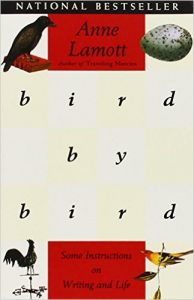 I debated whether or not I should write about this book, as it’s well outside my usual fare and perhaps only of interest to the handful of people who feel themselves cursed by the desire to write, but my commitment to blog about everything I read and my enjoyment of the book compelled me. Anne Lamott is a fiction writer, but by far her most popular book has been Bird By Bird, subtitled “Some Instructions on Writing and Life,” a kind of self-help book for the aspiring author. There is, in fact, an entire cottage industry built around teaching people to write, and many a writer has made more money in teaching the craft than practicing it. These books typically fall into one of two categories: the nuts-and-bolts, how-to-write-a-sentence variety, focused specifically on grammar or prosody or plotting, and the quasi-spiritual variety, which are apt to explain your writer’s block in terms of your self-loathing or pressing fears of inadequacy. I have found both varieties useful, because as much as we like to speak about writing as a craft, as a skill to be honed, the truth is that only a very disturbed person would ever think of committing themselves to long hours of solitude in front of a computer screen or blank piece of paper, and whatever rewards may accrue to those who make the effort, the only certainties are frustration, doubt and the nagging conviction that there are probably better ways to spend one’s time.
I debated whether or not I should write about this book, as it’s well outside my usual fare and perhaps only of interest to the handful of people who feel themselves cursed by the desire to write, but my commitment to blog about everything I read and my enjoyment of the book compelled me. Anne Lamott is a fiction writer, but by far her most popular book has been Bird By Bird, subtitled “Some Instructions on Writing and Life,” a kind of self-help book for the aspiring author. There is, in fact, an entire cottage industry built around teaching people to write, and many a writer has made more money in teaching the craft than practicing it. These books typically fall into one of two categories: the nuts-and-bolts, how-to-write-a-sentence variety, focused specifically on grammar or prosody or plotting, and the quasi-spiritual variety, which are apt to explain your writer’s block in terms of your self-loathing or pressing fears of inadequacy. I have found both varieties useful, because as much as we like to speak about writing as a craft, as a skill to be honed, the truth is that only a very disturbed person would ever think of committing themselves to long hours of solitude in front of a computer screen or blank piece of paper, and whatever rewards may accrue to those who make the effort, the only certainties are frustration, doubt and the nagging conviction that there are probably better ways to spend one’s time.
Bird By Bird presents itself mostly as a self-help book for struggling writers, with a handful of practical tips mixed in for good measure (On characters: “They shouldn’t be too perfect; perfect means shallow and unreal and fatally uninteresting”; on perfectionism: “Perfectionism means that you try desperately not to leave so much mess to clean up. But clutter and mess show us that life is being lived. Clutter is wonderfully fertile ground”), but it is also, slyly, a very personal memoir. We learn, for example, that Anne has an asthmatic son, that her father died of brain cancer, that her best friend died young, of breast cancer, and that, at the time of her writing this book, she is seven years sober. She teaches a writing workshop, and her students, too, suffer from various traumas, from divorce and depression to childhood physical abuse, and so it is small wonder that she is an advocate for the medicinal powers of fiction, both in reading and in writing. She quotes approvingly from Macbeth: “The labour we delight in physics pain.” A look at the chapter titles confirms this approach, as practical chapters on “Shitty First Drafts” and “Plot Treatments” combine with “Broccoli,” on trusting your intuition, and “Radio Station KFKD” (Radio Station K-Fucked), on that incessant doubting, self-deprecating voice familiar to anyone who has done any creative work whatsoever.
How helpful are these sorts of books, ultimately? I have serious reservations that good writing can be taught, but Lamott’s writing-as-therapy approach will get most people over that first hurdle of putting pen to paper. Upon finishing the book, I woke up early the next morning and began to write.